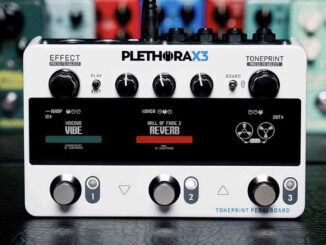Hologram has released the Chroma Console, a new multi-fx pedal that makes your instrument sound like vintage recordings and beyond.
One of the most successful pedals in recent years was the Hologram Microcosm. A fascinating stereo multi-FX processor with granular, etc., that caused a stir. Also, in the synth world. Every time I looked on the website, it was sold out. But there is also a time after this.
Today, Hologram Electronics returns with a new pedal. This addresses a topic that has been unavoidable when making music in the last two years. The degradation of digital sound to achieve more retro, lo-fi timbres. Please welcome Chroma Console.
Hologram Chroma Console
Chroma Console is a new stereo multi-FX processor that takes inspiration from the eccentricity, grit, and lively instability of beloved vintage recording technology, say the developers.
The colorful, lovely design of the pedal is immediately noticeable. Even though it’s a modern pedal, it still looks retro at the same time. This has a heavily color-coded interface, which is intended to simplify operation.
Chroma Console’s core consists of four rearrangeable effects slots, allowing you to re-order effects and experiment with different signal chains easily. This unlocks wild combinations like reverb in a distortion.
20 Algorithms
The pedal has 20 algorithms in total that can be freely used in the slots. They are available in four categories.
The character category is red and gives you everything that spices up your signals: a tube-like drive, a pleasant preamp, fuzz, a resonant filter fuzz (howl), and a swell generator.
Then, movement features effects that warp your sounds with vintage-style modulations: a double tracking effect (doubler), vibrato with lush pitch mods, vintage-voiced phaser, tremolo, and pitch shifter.
Diffuse gives you a wide range of unique time-based effects:
- cascade – the crunchy aspects of a BBD delay
- reels – a well-worn tape echo.
- space – a versatile reverb,
- collage – an atmospheric delay with pitch bending, granular, and glitch
- reverse – a reverse delay with variable playback speed/pitch
The last section, Texture, is just as exciting. It’s all about textural effects.
- filter: multimode filter with three selectable filter options
- squash – a heavy-handed compressor and overdrive
- cassette – all the beloved effects we know from cassettes in an algorithm: wow, flutter, warple, tape degradation and pitch artifacts
- broken – “mangled sounds of motorized audio equipment in need of service.”
- interference – effects inspired by telecom network glitches and radio static.
Extra Creativity
In order to make these effects even more versatile and complex, Hologram has built in some other unique features in Chroma Console related to live performances.
First, you can record motion recordings using a hands-on modulation tool called gesture. It is great for creating effects that move constantly, and this can be in sync with your other gear.
Another addition is drift, which adds instability and unpredictability to the parameters. In practice, you can add randomness, chaos, and more to give them a more organic feel.
Further, you capture moments by looping up 30 seconds and sustain them endlessly using the CAPTURE functionality. This is a beautiful tool for creating droning pads or looped musical phrases with the press of a single-foot switch. And very clever, you can route it before or after the effects.
And with the dual bypass function, you can easily assign selected modules to the bypass foot switch. All this is storable in prests and can be combined with the trails mode.
Made For Synths
I often criticize that modern effects pedals are too stuck in the guitar-only bubble. Hologram Electronics shows it differently.
Chroma Console has full MIDI support over DIN and USB-C, including MIDI sync, MIDI CC, and instant preset recall with program changes. Plus, the stereo I/O is not only designed for guitar but also for line-level inputs. You can also flexibly configure if you run the pedal in mono-stereo or stereo-stereo.
Additionally, you can save your effects chains in 80 user presets.
First Impression
Damn, I have a massive GAS. Chroma Console looks like a super exciting multi-FX pedal with many special algorithms. One that harmonizes perfectly with synths and electronic sounds.
Above all, the flexibility and the hands-on design make it very appealing. I’m already anticipating long delivery times because I’m pretty sure this will be another big seller.
Hologram Chroma Console is available now for $399 + VAT + shipping. It’s limited to one per customer and arrives before Christmas, say the developers.
More information here: Hologram Electronics






Sick!!!
Looks more exciting to me than the similar Endorphin.es/Andrew Huang recent pedal release… I think this will replace my Blooper
Well tbf, that “new” End. pedal is just an older Eurorack module newly-re-housed into pedal format. And these two are not at all that similar beyond both being Master-Friendly multi-FX that are happy on the floor as well…
So I guess that makes sense!
Where’s the overlap with the Blooper and this thing? ¯\_(ツ)_/¯ If anything, it’s more of a Mood II / Gen. Loss II combo. Not interested. Microcosm was boring as hell as well, sold it after a few months due to it being in your face all the time. Sounds good? Yeah. But it’s just the same thing over and over, like drenching your music in reverb to cover up how shitty your music is. A shortcut to your typical sequenced youtube jam. No thanks.
I use Blooper as a straight delay with the stability knob turned up… tape delay > cassette with the drift enabled seems like a similar use case, with two more available slots! And this one and the Endorphin.es one (which is a pedal in its own right, or do you put the pedal in your eurorack case?) are both flexibly routable multifx, seems pretty similar to me! I like the FX on this one better. Thanks guys, anyone else with feedback for my comment is welcome to join in the fun!